As Above, So Below:
The Finger of Apollo, The Tree of Life and Carl Jung’s Collective Unconscious in the work of Frances Clarke
– Rob Maconarchie, July 2020

Above: Plate I from, Indian palmistry, by Mrs J. B. Dale, 1895
“As goodness stands in the intelligible realm to intelligence and the things we
know, so in the visible realm the sun stands to sight and the things we see.
– Plato, The Analogy of the Sun” from The Republic (507b–509c)
In the Twentieth-century hand-reading or Chirology received renewed attention and interpretation by, among others, followers of Carl Jung. In his introduction to the German Jewish Psychochirologist Julis Spiers’ book, The Hands of Children (1944) Jung writes, “The totality-conception of modern biology which is based on the evidence of a host of observations and research does not exclude the possibility that hands, whose shape and functioning are so intimately connected with the psyche, might provide revealing and, therefore, interpretable expressions of psychical peculiarity, that is, of human character.”
For Jung–whose theory of the Archetypes and the Collective Unconscious argues, not only that we exist within an infinite transpersonal order, but also that the macrocosm (the universe/God) and the microcosm (the physical world/human beings) are inherently connected–the psychical peculiarity revealed by hand-reading is that we are all connected; to one another, but also to the universe – everything is in everything; as above, so below. Read more…
The Finger of Apollo is the subject of artist Frances Clarke’s, The Blue Pearl Installation Project. Currently in development, the work comprises a vast assemblage of digital images produced from the fingers of hundreds of participants created using a cutting edge bio-technology known as Electrophotonic Imaging (EPI) which renders a computer generated analysis of the finger’s electro-photonic emissions. Also referred to as the Human Energy Field (HEF), this electrophotonic glow is produced by an invisible electromagnetic field generated by and specific to each and every one of us which is constantly interacting with the world around us, forming and informing an infinite number of further energy fields. By scanning the finger in a high-intensity electromagnetic field generated on the lens of an EPI device and applying a momentary weak electrical current, Clarke is able to capture the otherwise invisible glow of the resulting electron cloud formed by the stimulation of light energy photons on the fingertips. The image data is translated by the EPI system into graphics which evaluate energy variations in the body. The Blue Pearl Installation Project, comprises an immersive matrix of these EPI data images generated from The Apollo Finger of the left hand. The installation presents the energetic imprints from hundreds of participants, constructing an environment in which universal interconnectivity is not only visually represented but – as their awareness of interconnectivity expands through repetition of the motif – is also experienced collectively in real time by each viewer and group of viewers within the space. More than merely representing the notion of traditional matrimonial union and harmony which the ring finger denotes, Clarke’s specific focus on the Finger of Apollo actively reveals the universal connectivity innate to both the Jungian concept of the Collective Unconscious and the Hermetic axiom “as above, so below.”
In a secular context, “as above, so below” can refer to the idea that the microcosm (an individual) reflects the macrocosm (society), for example, that individual or domestic problems can result from larger societal ones. On a spiritual level it can be interpreted as the goal of releasing the spirit from the imperfection of physical existence – the transformation of opposites into a harmonious whole. Jung interpreted it as symbolic of the process of becoming psychologically evolved, a process he termed individuation. All three of these interpretations are at work In The Blue Pearl Installation Project which approaches the traditional alchemical phrasing of the idea via Jung’s styling of it – “as within, so without” or “as the soul, so the universe.” The genesis for the idea is an ancient text known as The Emerald Tablet believed to have been authored by the Eygptian deity Hermes Trismegistus, from whose name Hermeticism is derived. A translation of the text first surfaced in an 8th century Arabic book which mentions that the original tablet was unearthed from a tomb below a Hermetic shrine in Anatolia. Translated into Latin in the 12th century, it is one of the cardinal texts of Western alchemy. ‘What is above is similar in every respect to what is below’ has been interpreted to mean that human beings are composed of the same matter as both the Earth and the cosmos. A complex thought, but one which is equally relevant to the alchemical hypothesis that body and mind can become one with the Creator, as it is to the concept ‘you are what you eat’. Our understanding of nutrition is obviously scientifically based, though opinions on what is deemed science have altered with time. For example Isaac Newton put no less effort into alchemical research than he put into mathematics and physics. His Latin translation of the Emerald Tablet discovered amongst his unpublished papers on alchemy after his death attest to the shifting of parameters between science and occultism through the ages, a duality which is at the heart of Clarke’s The Blue Pearl Installation Project.
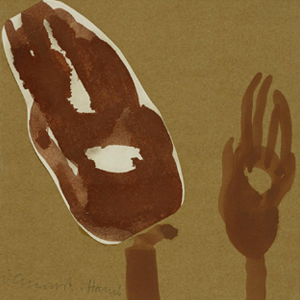
. Joseph Beuys (1921–1986), Demonstration: Hand, 1961, Collage and oil on paper and cardboard, 220 × 220 mm, Tate and National Galleries of Scotland
In an art historical context, the project sits within a space occupied by the scientist-turned artist, Joseph Beuys and the hermetic mysticism of Paul Klee for whom cosmology, alchemy and the artist’s hand were of primary importance. Klee believed his hand to be “completely the tool of a remote sphere.” In a description which conjures an image uncannily similar to those generated by the Human Energy Field in Clarke’s EPI data, Klee wrote: “Out of the fingertips of the artist arise line, shade, and color, to populate the world in their distinct way. ” In “Creative Credo,” his first theoretical essay written in 1918 Klee uses the example of the act of drawing to explain his picture theory: “a certain fire flares up; it is conducted through the hand, flows to the picture and there bursts into a spark, closing the circle whence it came: back into the eye and farther.” The French philosopher Maurice Merleau-Ponty cites this tract from Klee’s text in his poetic analysis of painting as a form of vision in, Eye and Mind (1964): “In the immemorial depth of the visible, something has moved, caught fire, which engulfs his body; everything he paints is an answer to this incitement, and his hand is ‘nothing but the instrument of a distant will.'” This cosmic tooling of the artist’s hand positions it as a bridge between heaven and earth, between divine inspiration and the act of creation, a motif often used by Joseph Beuys. Beuys also considered the hand of the artist to be imbued with a cosmic creative power. In Demonstration: Hand (1961) (fig.1) two hands are depicted: on the left a hand possibly based on the dimensions of the artist’s own; and on the right, a hand with more animalistic qualities, pointing to the union of man and nature. Beuys presents the hand as a symbol of creative defiance, but also refers to the simple act of consciousness connoted by the rudimentary hand-print.
The artist’s hand was a subject given great attention in the 1960s during the early years of Conceptual Art following Marcel Duchamp’s call for an art that appealed to the mind rather than seducing the eye. Clarke’s work does both these things. It maintains an insistence on the power of creativity inherent in the hand of the artist (a belief shared by both Beuys and Klee) but uses an all encompassing definition of “artist” informed by Joseph Beuys’ theory of Social Sculpture. Reacting to later developments born out of Duchamp’s call for analysis over artifice, in 1973 Beuys developed a view of the social organism as a work of art. Only art Beuys said “is capable of dismantling the repressive effects of a senile social system that continues to totter along the deathline.” This Social Sculpture would only reach fruition, he believed, when “every living person becomes a creator, a sculptor, or architect of the social organism” when, “Every Man is an artist.”
An essentially hermetic idea, Beuys’ theory for the process of social transformation (the transformation of matter) was part of a mythology constructed from fragments of folklore, literature, philosophy, anthroposophy, the history of science – and in particular, from alchemy. In Hermetic Alchemy The Blue Pearl is considered to be the end point of evolution, the ultimate goal of “The Great Work” an unpolarized integrated consciousness linking all of humanity to nature and returning us to our prelapsarian God-like state (as above, so below). However, according to the hermetic teachings evolution will remain incomplete until such time as this connection is made and we consciously agree to our part in creating wisdom on Earth. Therefore, as with Beuys’ Social Sculpture, Hermeticism posits that all human beings are artists whose work it is to transmute all polarised form into one universal consciousness. Ultimately, as humanity evolves from ignorance towards wisdom, the Earth itself becomes the Philosopher’s Stone – the Blue Pearl.
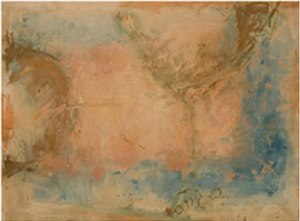
Frances Clarke, As Above So Below I, 1995, oil drawing on paper, 30.9 x 23 cm
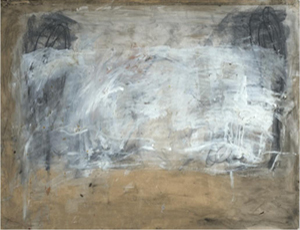
Frances Clarke, Duality I, 1998, oil on paper, 84 cm x 118 cm
Frances Clarke’s earlier work and her more recent Blue Pearl series shares similar socially oriented hermetic thinking. The amorphousness of paintings such as As above, So Below I (1995) (Fig.2) and Duality I (1998) (Fig.3) anticipate the glowing electron clouds rendered in the installation project. In The Blue Pearl (2020) a participatory work which precedes the recent installation project, Clarke examined the cyclical framework of the aesthetic experience using EPI bio-technology to analyze the object/spectator relationship. Effectively creating a microcosm of the role of creativity in larger societal structures, the work traces the flow of energy between artist, object and viewer, emphasising the interconnectivity of the relationship in which the artist’s bio-energy, enmeshed within the painting in the process of creation, is transferred to the viewer in the moment of appreciation and dispersed via future interactions. In The Blue Pearl Installation Project, Clarke has developed her thinking around the Electrophotonic Imaging technology further, incorporating it into a kind of visual metaphor triggered by an association with the Sun God Apollo, a metaphor which has parallels with “The Analogy of the Sun” from Plato’s, The Republic. Like a microcosm of Plato’s sun, which, in the visible realm “stands to sight and the things we see”, the EPI device reveals the invisible extrasensory cosmos within each of us, which although unseen, is integral to human experience and our interactions with both the visible world and the invisible realm of universal consciousness. Clarke seems to be saying that life depends on sun energy; scientifically but also psychologically and mystically. Like trees photosynthesizing in the warmth of its rays, we are all children of the Sun. As above, so below.
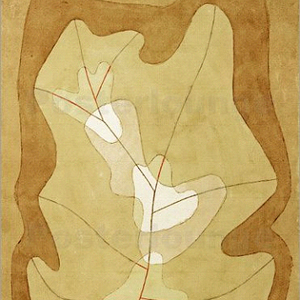
Paul Klee (1879-1940) Illuminated Leaf [belichtetes Blatf), 1929, Watercolor and pen on paper on cardboard, 30.9 x 23 cm, Zentrum Paul Klee, Bern.
Clarke’s use of the hand as the site from which to examine the conjunction of the inner and outer vision of things, also connects her practice to the hermetic and transcendentalist practice of Paul Klee. At the point of conjunction between the inner and outer realms Klee wrote “are rooted the forms created by the hand.” Influenced by Goethe’s insight, “everything is leaf”, an idea he was first made aware of in Rudolf Steiner’s 1918 lecture on Gothe’s The Metamorphosis of Plants, Klee likenned the artist to a tree from whose fingertips, like unfolding leaves, arise line, shade, and colour (Fig.4). Extendeding Goethe’s idea to encompass the entire natural order, including human beings, this connection between hand and leaf had been made four decades earlier by the American transcendentalist philosopher Henry David Thoreau who observed “Is not the hand a spreading palm leaf with its lobes and veins.” In the “Spring” chapter from Walden (Life in the Woods) first published in 1854, Thoreau–identifying God/The Creator as an artist–imagines himself witnessing the moment of Creation in the studio of the “artist who made the world and me” wherein the “overhanging leaf” is revealed to him as the “prototype” of nature. “You thus find in the very sands” writes Thoreau “an anticipation of the vegetable leaf…. The feathers and wings of birds are still drier and thinner leaves…. Even ice begins with delicate crystal leaves…. The whole tree itself is but one leaf, and rivers are still vaster leaves.” Paul Klee continues this idea of microcosm and macrocosm writing himself in 1923: “A leaf is part of the whole. If the tree is an organism, the leaf is an organ. The small parts of the whole are again articulated in themselves…. The articulation of the whole is defined by roots, trunk and crown. The articulation of a leaf is defined by stem, veins, and leaf tissue.” He defined the nature/artist correlation further in On Modern Art a lecture/artist statement given in 1924 in which he stated: “The roots of the tree are the spreading of sensuous information that is received and ordered by the artist, as they recognise order in nature and life. From this spreading rootedness in life the artist receives a fecund flow of impressions that through them and in them constitute the sap that feeds the creative work. The artist withstands this flow and from it moulds vision into a work of art. Standing as a trunk the artist sees the works spread beyond them much like the crown of a tree with its branches and foliage.” The tree, as Galen A. Johnson has noted, is thus a metamorphosis of leaf. As above, so below.
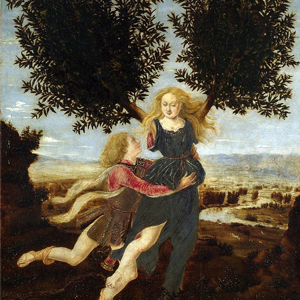
Apollo and Daphne, c.1470–1480, oil on panel painting, attributed to Piero del Pollaiolo and/or his brother Antonio, National Galllery, London
As Claudia Baracchi has noted in the context of Klee’s work, “in its axial organization, cohesiveness, and dynamism, the tree evokes as well the human microcosm.” Baracchi cites Plato’s delineation in Timaeus of the essential traits of the human. The human being, Plato suggests, is the upside down tree rooted in the sky and turning its flowering, creative organs toward the earth an inversion intimating the human as a reflection, a mirror image of the divine. (An image which brings to mind the metamorphosis of Daphne (Fig.5.) Resonating with France Clarke’s cosmic images of the Human Energy Field in The Blue Pearl Installation Project, Baracchi describes humanity as “the descent of the sky into the earth, and the earth’s creative response.” She adds that “while belonging in the earthly element, and therefore fruitfully enacting itself in ways always local and irreducibly singular, the human being remains connected to the openness of the all-embracing sky, and in virtue of this may cultivate the consciousness of its own participation in a choral unity.”
Clarke’s Blue Pearl Installation Project presents an image of potentiality. It reminds us that, as Baracchi points out, we all have the ability to cultivate our own participation in a conscious unity. Like Beuys and Klee, Clarke undertakes to illuminate the human being under the aspect of artistic creativity. Like a teacher or visionary she presents the universal potential for forming consciousness which is inherent in us all. We just need to pay attention. As the work of Beuys, Klee and Clarke attests, artists are especially well equipped to help reveal humankind’s potential to transcend. In this way The Blue Pearl Installation Project is a mediation. Not on any particular expression, or technique, or object or form, but of the act of forming. Of forming connections: groups, societies, communities, teams, congregations, forums, friendships…It is a meditation on the act of connecting. To ourselves and each other, but also to the universe. It is a reminder, that even in our most obstinate refusal to surrender our singularity (our individuality), we are, all of us (and all of IT – it out there – the cosmos) made from one and the same thing. Let us, therefore, think, like Klee, “not of form but of the act of forming…. Let us step by step translate this tendency from the small to the larger, advance towards the realisation of the whole, retain creative leadership and never allow the creative reins to drop from our hands.”
FOOTNOTES
-
1. Carl Jung in introduction to Julius Spier, The Hands of Children ; Kegan Paul, Trench, Trubner ;
London, 1944 -
2. Quoted in O. K. Werckmeister, The Making of Paul Klee’s Career, 1914- 1920 (Chicago: University of
Chicago Press, 1989), pp.180-181 - 3. Paul Klee, “On Modern Art” 10.
- 4. “Paul Klee, “Creative Credo” 1918
- 5. Merleau-Ponty, Eye and Mind, 147; L’oeil et Tesprit, 86.
-
6. Ann Temkin and Bernice Rose, with a contribution by Dieter Koepplin, Thinking is form: the drawings of
Joseph Beuys, Philadelphia Museum of Art; The Museum of Modern Art, 1993, p.103. What Duchamp’s
tenet of the early 1940s defines, is the division he saw between Cubism’s analytical approach and the
formalist attitude of Futurism. See Duchamp’s comments in his interview with James Johnson Sweeney,
“Eleven Europeans in America,” The Museum of Modern Art Bulletin 13, nos. 4-5 (1946):2 - 7. He of course meant Human
-
8. Dr. Konstantin Korotkov, PhD, Professor of Computer Science and Biophysics at St. Petersburg University
of Informational Technologies, Mechanics and Optics and the developer of the EPI technology explains:
“Energy from the sun is converted into electron energy and as a result, a series of transformations in
complex chains of albuminous molecules are converted into our body energy. So it can be said that
biological life is based on light energy, and organic compounds serve as the working material for the
conversion of this energy.” Korotkov et al., 2004 https://gdvcamera.com/electrophotonics-scientific-basis/
accessed 20/07/2020 -
9. Paul Klee, “Wege des Naturstudiums,” in Paul Klee: Kunst-Lehre, Gunther Regel (ed.) (Leipzig: Reclam,
1987) p.126 -
10. Paul Klee, “On Modern Art” (1924), translated by David Farrell Krell in Paul Klee : philosophical vision,
from nature to art, John Sallis (ed.), McMullen Museum of Art, Boston College, The University of Chicago
Press, 2012. - 11. Henry David Thoreau “Spring,” in Walden (1854; Boston: Beacon Press, 1997), pp.286-89
-
12. Michael Baumgartner, ‘”Reducing the contingent to its essence’: Paul Klee’s Dialogue with Nature,” in, In
Paul Klee’s Enchanted Garden, Michael Baumgartner and Marianne Keller, (eds.) exh. cat. (Ostfildern:
Hatje Cantz, 2008), p.30, quoted in Paul Klee : philosophical vision, from nature to art - 13. Paul Klee, “On Modern Art” (1924) op cit.
-
14. Galen A. Johnson “Metamorphosis and Music: Klee and Merleau-Ponty” in Paul Klee : philosophical
vision, from nature to art op cit. -
15. Claudia Baracchi “Paul Klee: Self-Portrait of the Artist as a Tree” in Paul Klee: philosophical vision, from
nature to art - 16. Plato Timaeus, 90a.
- 17. Claudia Baracchi op cit.
-
18. Paul Klee, Notebooks. Volume 2: The Nature of Nature, ed. Jurg Spiller, trans. Heinz Norden (London:
Lund Humphries, 1973) p. 67.